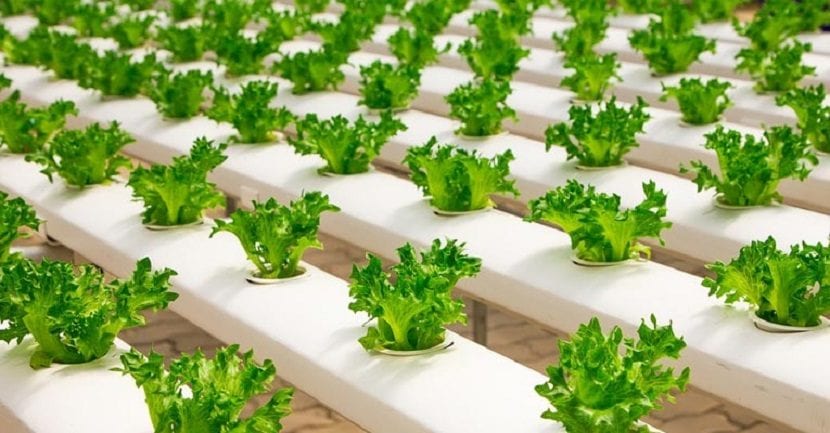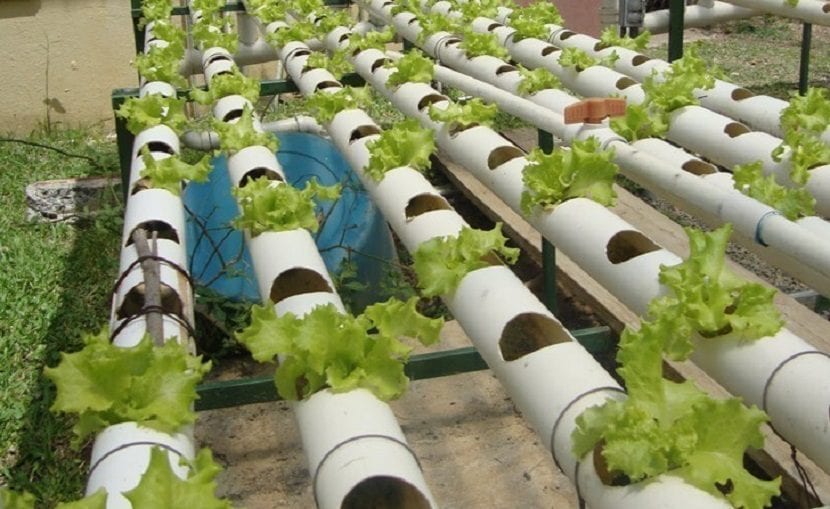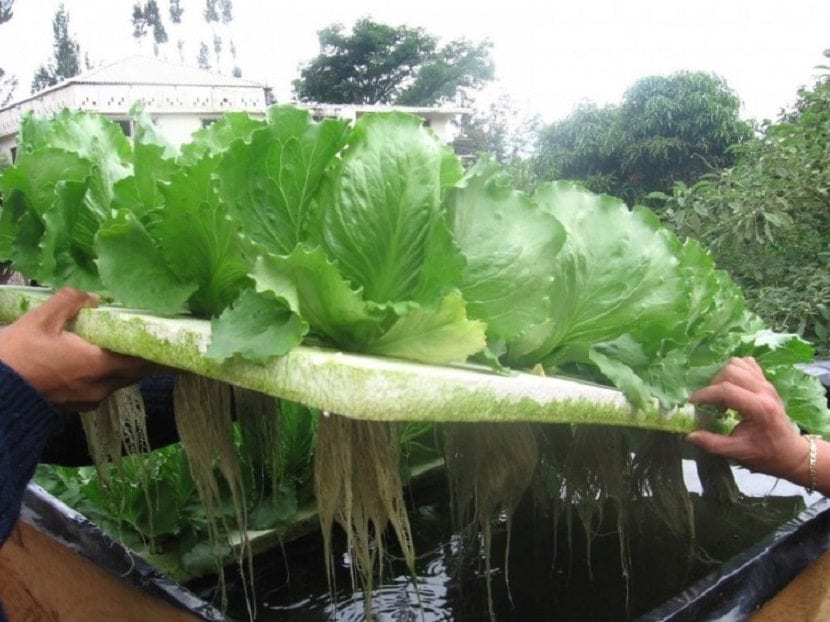
Hydroponic crops are crops that are characterized by the absence of soil and they emerge as an alternative to traditional agriculture.
The main objective of hydroponic crops is to eliminate or mitigate the limiting factors of plant growth that are associated with the properties of the soil, replacing it with other cultivation supports and using other various fertilization techniques.
The name of these crops is given by the name of hydroponics, which is an inert support such as peat, sand, gravel where the roots of the crop are suspended in the nutritive solution itself.
This causes the solution to have a constant recirculation, preventing the anaerobiosis process that would cause the immediate death of the culture.
As well plants can be found inside a PVC chamber or from any other material that has perforated walls (by means of which the plants are introduced), in this case the roots are in the air and will grow in the dark and the nutritive solution is distributed by means of medium or low pressure spraying.

Thanks to the studies of the environmental impacts that have been carried out in recent years on the soil and surface waters and runoff or from the agricultural activity itself on the atmosphere, we can verify that hydroponic crops or crops without soil have very different characteristics compared to traditional crops on the table:
- The capacity to host waste and by-products to be used as growing substrates.
- Rigorous control of one's own water and nutrient supply, especially when working with closed systems.
- It does not require large spaces, which is why it is especially profitable from an economic point of view.
- It provides the roots at all times with a constant level of humidity, regardless of the climate or the growth stage of the crop.
- Reduces the risk due to excess irrigation.
- Avoid the useless waste of water and fertilizers.
- Ensures irrigation in the entire root area.
- It considerably reduces the problems of diseases caused by soil pathogens.
- Increase yields and improve production quality.
However, crops of this type generate a series of pollutants, especially those that are intervened by industries, coming from:
- Nutrient leaching in open systems.
- The dumping of waste materials.
- The emission of phytosanitary products and gases.
- Extra energy consumption as a result of proper heating and maintenance systems.
Types of hydroponic crops
Nutrient Film Technique (NFT)
It is a production system in soilless crops where the nutrient solution recirculates.
The NFT is based on the continuous or intermittent circulation of a thin sheet of nutrient solution through the roots of the crop, without these being immersed in any substrate, therefore they are supported by a cultivation channel, inside which the solution flows towards lower levels by gravity.

The system allows greater water and energy savings as well as more precise control over plant nutrition and is also capable of sterilizing the soil and ensures a certain uniformity between plant nutrients.
However, a study of the nutritive dissolution has to be carried out, as well as the rest of the physicochemical parameters such as pH, temperature, humidity ...
Flood and drainage system
This system consists of trays where the plants planted are located in an inert substrate (pearls, pebbles, etc.) or organic. These trays they are flooded with water and nutrient solutions, which are absorbed by the substrate.
Once the nutrients are retained, the trays are drained and re-flooded with the specific solutions.
Drip system with nutrient solution collection
It is the same as traditional drip irrigation but with the difference that excess is collected and pumped back to culture according to the needs of the same.
The collection of the excess is possible thanks to the fact that the crop is on a slope.
DWP (Deep Water Culture)
This is the type of cultivation most similar to the one used in ancient times.
It consists of pools over which the plants are placed on a plate, leaving the roots in contact with the water with the added solutions. Being stagnant water, it is necessary to oxygenate it using pumps similar to those in an aquarium.
Ecological benefits of the hydroponic growing system
We have already seen some advantages of hydroponic crops but we must also see the ecological benefits that they can provide, such as:
- The liberation of the presence of weeds or pests in the plants themselves.
- This type of cultivation is very useful to use on land that is already very worn or scarce since it favors the rest of the land.
- Just as it does not depend on climatic conditions, so it guarantees the plant variety during the year.
Classification of substrates
As I mentioned earlier, there are various materials for making a hydroponic crop.
The choice that is made of one material or another is determined by several factors such as its availability, cost, the purpose of the production of said crop, the physical-chemical properties, among others.
These substrates can be classified into organic substrates (if it is of natural origin, of synthesis, of by-products or of agricultural, industrial and urban waste) and on inorganic or mineral substrates (of natural origin, transformed or treated, and industrial waste or by-product).
Organic substrates
Among them we can find mobs and wood barks.
Mobs
They are constituted by remains of moss among other plants, which are in the process of slow carbonization and therefore out of contact with oxygen due to an excess of water. As a consequence, they are able to preserve their anatomical structure for a longer time.
There may be 2 types of peat, depending on the origin of their formation since plant residues can be deposited in various ecosystems.
On the one hand, we have the herbaceous or eutrophic mobs and on the other hand, we have Sphagnum or oligotrophic mobs. The latter are the most used today, due to their organic components, for culture media that grow in pots. This is due to its excellent physico-chemical properties.
However, and despite the fact that for almost 30 years mobs have been the materials most used as substrates, little by little they have been replaced by inorganic ones, which we will see below.
In addition, the reserves of this type of substrate are limited and non-renewable, so its use in excess can cause a very important environmental impact.
Wood bark
This designation includes both the inner bark and the outer bark of trees.
The most used are the bark of the pines although barks of various species of trees can also be used.
These barks They can be found fresh or already composted.
The former can cause a nitrogen deficiency and also phytotoxicity problems, while composted barks reduce these problems considerably.
Its physical properties depend on the size of the particle, but the porosity usually exceeds 80-85%.
Inorganic substrates
In this type of substrates we can find rock wool, polyurethane foam, sand perlite among others, which I will not detail in depth, but will give small strokes so that you can have a slight idea. If you want more information, do not hesitate to comment.
Rock wool
It is an industrially transformed mineral. It is fundamentally an aluminum silicate with the presence of calcium and magnesium, together with traces of iron and manganese.
Advantages:
- High water retention capacity.
- Great aeration
Disadvantages:
- Requirement of a perfect control of hydric and mineral nutrition.
- Elimination of waste.
- It can be carcinogenic although it is not scientifically proven.
Polyurethane Foam
It is a porous plastic material formed by an aggregation of bubbles, also known by the colloquial names of foam rubber in Spain.
Advantages:
- Its hydrophobic properties.
- Its price.
Disadvantages:
- Waste disposal, just like stone wool.

Perlite
It is an aluminum silicate of volcanic origin.
Advantages:
- Good physical properties.
- It facilitates the management of irrigation and minimizes the risks of suffocation or water deficit.
Disadvantages:
- Possibility of degradation during the cultivation cycle, losing its granulometric stability, which can favor waterlogging inside the container.
Sand
Material of a siliceous nature and variable composition, which depends on the components of the original silicate rock.
Advantages:
- Low cost in countries where it is found in abundance.
Disadvantages:
- Problems derived from the use of certain low quality sands
Preparation of nutritional solutions
The preparation of nutritional solutions is based on a previous balance between nutrients from irrigation water and the optimal values for that crop.
These nutritive solutions can be prepared from stock solutions, with a concentration 200 times higher than the final solution or about 1.000 times higher in the case of macroelements and microelements respectively.
Furthermore, the pH of these solutions is adjusted between 5.5 and 6.0 by adding NaOH or HCl.
How to Make a Homemade Hydroponic Growing System
Below is how to build a simple hydroponic growing system for 20 lettuces with the NFT (nutrient film technique) that we have seen previously.
We can see that with some simple homemade tools and common materials we can build our own hydroponic culture.
Note; the video does not have any music so I advise some background music track so that it does not seem so heavy to see.
This video has been made by the Faculty of Sciences of the UNAM in the Hydroponics Workshop.
Hello, I already saw it, but the root of the lettuce always turns brown when it is 12 days after the lettuce is planted, why?
This topic is very interesting, I really implemented it at home but I have a problem, my lettuces get longer, I don't know why. Somebody could help me??
Thank you